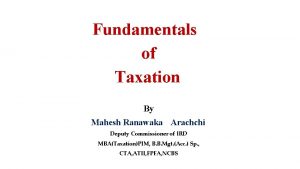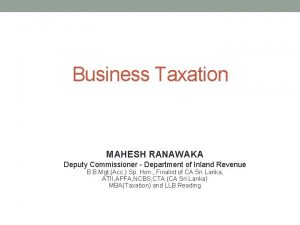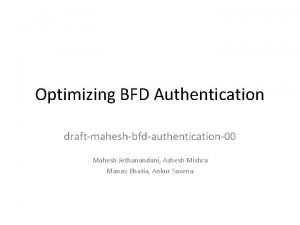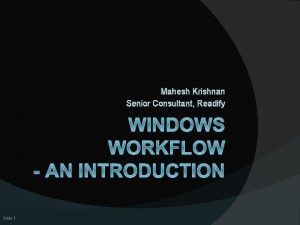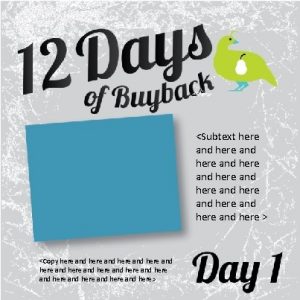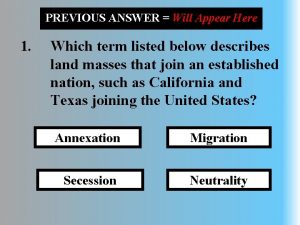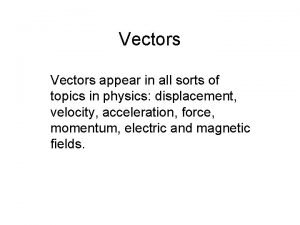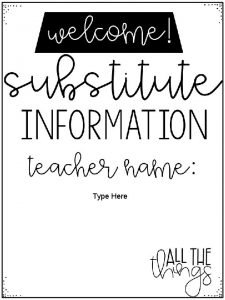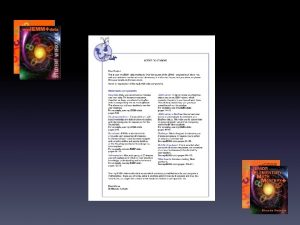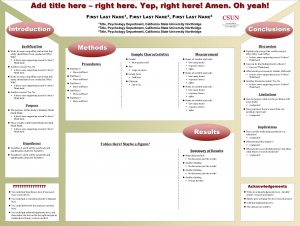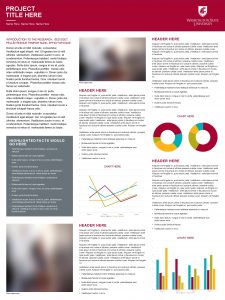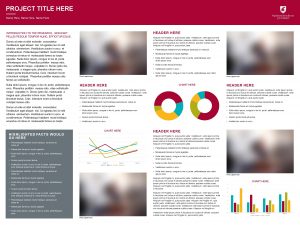All sections to appear here Mahesh Krishnan Principal



























- Slides: 27

All sections to appear here Mahesh Krishnan | Principal Consultant | Mahesh. Krishnan@readify. net | blogesh. wordpress. com

What is Expression Blend? • Primary Tool for Designing User Interfaces • Visually design UI – Blend creates XAML • Better user experience than Visual Studio when working UI design • You still need VS 2010 to do all the developer stuff

Blend vs Visual Studio • When would you use Expression Blend? – – – Prototyping UI User Interface design Writing small blocks of code Importing designs from Photoshop and Illustrator Animation • When would you use Visual Studio? – – Simple UI design Writing code Debugging, setting breakpoints, etc Integrating with other projects (. NET WCF Services, WCF, . . . )

Tour of Expression Blend • • Menus Tools Panel Assets Panel The Artboard – Different views • Properties Panel • Objects and Timelines Panel • . . .

Demo - Hello World Discover, Master, Influence Slide 9

Demo – Brushes Discover, Master, Influence Slide 10

Demo - Transformations Discover, Master, Influence Slide 11

Demo - Layouts Discover, Master, Influence Slide 12

Styling • Allows re-use of look and feel across controls: – Color, Font, Margins, etc • Created as a resource: <Application. Resources> <Style x: Key="Style 1" Target. Type="Text. Block"> <Setter Property="Foreground" Value="#FFF 0 D 3 D 3"/> <Setter Property="Font. Size" Value="36"/> </Style> </Application. Resources>

Applying a Style • Set using Style property using the Static. Resource mark-up in XAML: <Text. Block Text="Hello World" Style="{Static. Resource Style 1}" />

Demo – Styling a Button Discover, Master, Influence Slide 16

Skinning or Templating • Allows you to change the complete appearance of the control • Like Style, created as a resource: < Application. Resources> <Control. Template x: Key="My. Template" Target. Type="Button"> <Grid>. . . <Rectangle. . . /> <Content. Presenter. . . Content="{Template. Binding Content}" /> </Grid> </Control. Template> < /Application. Resources>

Applying the template • Set using Template property in XAML: <Button Content=“Click Me!" Template="{Static. Resource My. Template}" />

Managing States • Uses Visual State Manager – Allows setting different State groups for a control • Manages transition between states – Controls the look and feel of the control when state transition occurs • Allows designers to define state transition behaviour (usually done using Animation)

Demo – Skinning a Button Discover, Master, Influence Slide 21

The Parts Model

Demo – Templating Slider Discover, Master, Influence Slide 23

Introduction • Animation is created by quickly cycling through a series of images • Each image is slightly different from the previous one • Image is created by changing a (visual) property • Basic animations works on properties of type: – Double – Color – Point

Basic Animation • Storyboard – Container for animation – Manages timeline. Can start, pause, stop animations • xxxx. Animation (e. g. Double. Animation) – Specify From, To and Duration – Storyboard will do the interpolation

Basic Animation in XAML • XAML Syntax for Storyboard: <Storyboard x: Name="My. Storyboard"> <Double. Animation Storyboard. Target. Name="rect 1" Storyboard. Target. Property="Width" From="40" To="100" Duration="0: 0: 5"> </Double. Animation> </Storyboard>

Key Frame Animation • Animates between a series of values • XAML Syntax for Storyboard: <Storyboard x: Name="My. Storyboard"> <Double. Animation. Using. Key. Frames Duration="0: 0: 4. 5" Storyboard. Target. Name="rect 1" Storyboard. Target. Property="Width”> <Linear. Double. Key. Frame Value="140" Key. Time="0: 0: 0"/> <Linear. Double. Key. Frame Value="10" Key. Time="0: 0: 2. 2"/> <Linear. Double. Key. Frame Value="140" Key. Time="0: 0: 3"/> </Double. Animation. Using. Key. Frames> </Storyboard>

Demo – Animation Discover, Master, Influence Slide 29

Data Binding • Data binding is a connection between User Interface object and data • Aids in the separation of responsibility • You can also data bind value of one control to another

Demo – Data binding Discover, Master, Influence Slide 32

Data Binding XAML • Every (Dependency) Property in a control can be databound • In XAML, the following syntax is used: <Text. Box x: Name=“txt. ISBN" Text=“{Binding ISBN, Mode=Two. Way}“ /> • In code, the Data. Context property of the Text. Block is set to the actual object

Demo – Sample data

Want to find out more?
 Standardized recipe culinary definition
Standardized recipe culinary definition Dr biju krishnan
Dr biju krishnan Lavanya krishnan
Lavanya krishnan Ranjani krishnan
Ranjani krishnan Manjeri krishnan
Manjeri krishnan Ash krishnan
Ash krishnan Krishnan chatterjee
Krishnan chatterjee Chetan prakash vs met institute
Chetan prakash vs met institute Dev krishnan
Dev krishnan Dr lavanya krishnan
Dr lavanya krishnan Ranjith krishnan
Ranjith krishnan Principles of taxation
Principles of taxation Fabrication of data
Fabrication of data Zero error by mahesh patil
Zero error by mahesh patil Mahesh ranawaka
Mahesh ranawaka Mahesh jethanandani
Mahesh jethanandani Dr sachin marda
Dr sachin marda Cocoon stifling
Cocoon stifling Hb mahesh weebly
Hb mahesh weebly Ananya mahesh
Ananya mahesh We waited all through the year for the day to
We waited all through the year for the day to Name all the lines
Name all the lines There's a place where mercy reigns and never dies
There's a place where mercy reigns and never dies Abpc
Abpc Considered as a border between upper hell and lower hell.
Considered as a border between upper hell and lower hell. Now all has been heard here is the conclusion of the matter
Now all has been heard here is the conclusion of the matter Arti jehovah jireh
Arti jehovah jireh You were a lover before times beginning
You were a lover before times beginning











